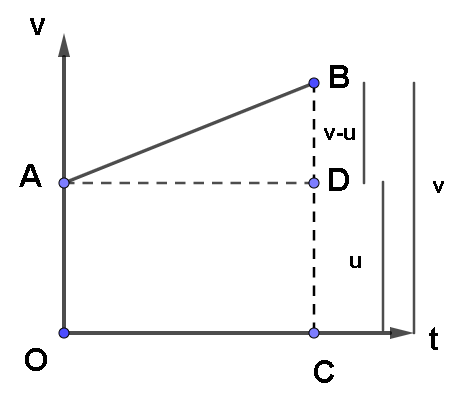
Derive the third equation of the motion-
Answer
494.1k+ views
Hint: The third equation of motion is the relationship between final velocity ‘v’, initial velocity ‘u’ , acceleration ‘and distance travelled ‘s’. We will start by considering that a body is moving with uniform acceleration. We will plot the v-t (velocity-time) graph for the body and using the graph we will reach the equation.
Complete step-by-step solution:
Let us first know a few terms:
1) initial velocity is the velocity with which the body first starts moving.
2) final velocity- velocity the body attains after completing its motion.
Let us start by considering a body, moving on a plane with uniform acceleration ’a’. let ‘u’ be its initial velocity ’v’ be its final velocity, ‘t’ be time travelled and ‘s’ be distance travelled. And ‘a’ is the acceleration .
We will plot a( v-t) graph to derive this equation:
Look at the following graph,

Here: OA=CD=u
BC=v
AND, OC=AD=t
As total height is v, then the height BD=BC-BD.
That is BD=v-u
We know that the slope of the v-t graph gives acceleration.
Hence, \[a = \dfrac{{BD}}{{AD}}\]
\[a = \dfrac{{BC - CD}}{{OC}}\]
\[a = \dfrac{{v - u}}{t}\]
\[t = \dfrac{{v - u}}{a} - - - - - - - - - - - \left( 1 \right)\]
Distance travelled by the body in time t= area enclosed by v-t graph.
We see that there is a trapezium formed with height ‘t’ and sum of parallel sides as ‘u’ and ‘v’ .
Hence the distance travelled by the body =area of the trapezium in the graph.
X=area of trapezium
\[x = \dfrac{1}{2} \times OC \times \left( {OA + BC} \right)\]
\[x = \dfrac{1}{2} \times t \times \left( {u + v} \right)\]
Now substituting value of t from equation 1, we get
\[x = \dfrac{1}{2} \times \left( {\dfrac{{v - u}}{a}} \right) \times \left( {u + v} \right)\]
\[x = \dfrac{1}{{2a}} \times \left( {v - u} \right) \times \left( {u + v} \right)\]
\[x = \dfrac{1}{{2a}} \times \left( {{v^2} - {u^2}} \right)\]
Or, \[x2a = \left( {{v^2} - {u^2}} \right)\]
Substituting x=s we get :
\[2as = \left( {{v^2} - {u^2}} \right)\]
\[\therefore {v^2} = {u^2} + 2as\]
Hence derived.
Note: The slope under the (v-t) graph gives acceleration.
The area under the curve of a (v-t) graph gives the displacement.
Remember to write BD=v-u , otherwise the whole derivation could go wrong.
Also all the equations of motion can be applied only when the acceleration is constant.
Complete step-by-step solution:
Let us first know a few terms:
1) initial velocity is the velocity with which the body first starts moving.
2) final velocity- velocity the body attains after completing its motion.
Let us start by considering a body, moving on a plane with uniform acceleration ’a’. let ‘u’ be its initial velocity ’v’ be its final velocity, ‘t’ be time travelled and ‘s’ be distance travelled. And ‘a’ is the acceleration .
We will plot a( v-t) graph to derive this equation:
Look at the following graph,

Here: OA=CD=u
BC=v
AND, OC=AD=t
As total height is v, then the height BD=BC-BD.
That is BD=v-u
We know that the slope of the v-t graph gives acceleration.
Hence, \[a = \dfrac{{BD}}{{AD}}\]
\[a = \dfrac{{BC - CD}}{{OC}}\]
\[a = \dfrac{{v - u}}{t}\]
\[t = \dfrac{{v - u}}{a} - - - - - - - - - - - \left( 1 \right)\]
Distance travelled by the body in time t= area enclosed by v-t graph.
We see that there is a trapezium formed with height ‘t’ and sum of parallel sides as ‘u’ and ‘v’ .
Hence the distance travelled by the body =area of the trapezium in the graph.
X=area of trapezium
\[x = \dfrac{1}{2} \times OC \times \left( {OA + BC} \right)\]
\[x = \dfrac{1}{2} \times t \times \left( {u + v} \right)\]
Now substituting value of t from equation 1, we get
\[x = \dfrac{1}{2} \times \left( {\dfrac{{v - u}}{a}} \right) \times \left( {u + v} \right)\]
\[x = \dfrac{1}{{2a}} \times \left( {v - u} \right) \times \left( {u + v} \right)\]
\[x = \dfrac{1}{{2a}} \times \left( {{v^2} - {u^2}} \right)\]
Or, \[x2a = \left( {{v^2} - {u^2}} \right)\]
Substituting x=s we get :
\[2as = \left( {{v^2} - {u^2}} \right)\]
\[\therefore {v^2} = {u^2} + 2as\]
Hence derived.
Note: The slope under the (v-t) graph gives acceleration.
The area under the curve of a (v-t) graph gives the displacement.
Remember to write BD=v-u , otherwise the whole derivation could go wrong.
Also all the equations of motion can be applied only when the acceleration is constant.
Recently Updated Pages
Why are manures considered better than fertilizers class 11 biology CBSE

Find the coordinates of the midpoint of the line segment class 11 maths CBSE

Distinguish between static friction limiting friction class 11 physics CBSE

The Chairman of the constituent Assembly was A Jawaharlal class 11 social science CBSE

The first National Commission on Labour NCL submitted class 11 social science CBSE

Number of all subshell of n + l 7 is A 4 B 5 C 6 D class 11 chemistry CBSE

Trending doubts
What is meant by exothermic and endothermic reactions class 11 chemistry CBSE

10 examples of friction in our daily life

One Metric ton is equal to kg A 10000 B 1000 C 100 class 11 physics CBSE

1 Quintal is equal to a 110 kg b 10 kg c 100kg d 1000 class 11 physics CBSE

Difference Between Prokaryotic Cells and Eukaryotic Cells

What are Quantum numbers Explain the quantum number class 11 chemistry CBSE




